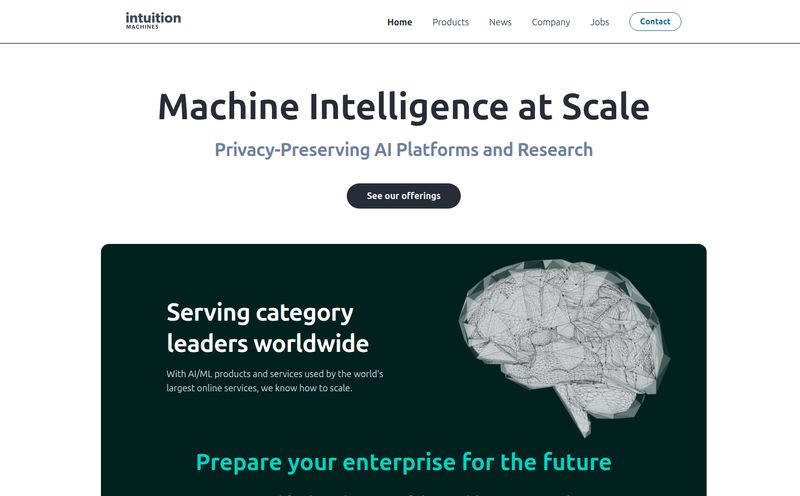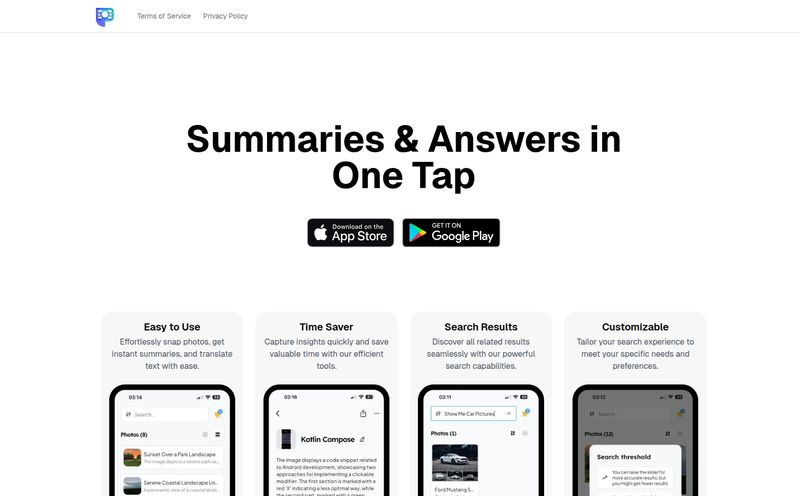Manual data entry. It’s the digital equivalent of watching paint dry. Worse, actually. At least with paint, you eventually get a nice new wall color. With data entry, you just get eye strain, a looming sense of dread, and the nagging feeling that a highly-trained, coffee-fueled monkey could do your job. And probably for less.
For years, we've been promised automation would save us. We'd be freed from the shackles of copy-paste to focus on big-picture strategy. Yet, here many of us are, still sifting through PDFs of invoices, email order confirmations, and scanned delivery notes, painstakingly moving information from one box to another. It's a massive time-suck and, frankly, a waste of human potential.
So when a tool comes along with the tagline "AI data extraction, made ridiculously simple," my inner SEO and process-nerd sits up and pays attention. That tool is Parseur. I’ve been hearing the buzz, so I decided to pop the hood and see if it lives up to the hype. Is this really the magic bullet for our document-processing woes?
What Exactly is Parseur? (And Why Should You Care?)
At its heart, Parseur is an intelligent document processing (IDP) tool. That's the fancy industry term. In plain English? It’s a smart piece of software that learns to read your documents—like PDFs, emails, Word docs, you name it—and pulls out the specific pieces of information you need. Think of it as teaching a super-fast, super-accurate assistant to read your mail and fill out a spreadsheet for you, 24/7, without ever asking for a day off.
The goal is to stop documents from being data graveyards. You know what I mean. That folder full of hundreds of supplier invoices or customer orders. The data is in there, but getting it out and into your CRM, your accounting software, or even just a Google Sheet is the hard part. Parseur aims to be the bridge that connects that static information to your active workflows.
How Parseur Works Its Magic
The whole process is refreshingly straightforward, which I appreciate. There's no need for a three-week implementation course. It boils down to a few key steps:
- Choose Your Mailbox: You start by setting up a 'mailbox' in Parseur. This isn't your normal email; it's a specific destination for a certain type of document. For example, you could have one for "Invoices" and another for "New Leads from Website Form".
- Send in Your Docs: You then forward your documents to this dedicated email address. You can also upload them directly or connect via their API.
- Teach the Machine: This is the cool part. You highlight the data you want to extract from a sample document. Point and click. Tell it "this is the invoice number," "this is the total amount," "this is the customer's name."
- Export and Automate: Once Parseur has learned the layout, it will automatically process every similar document you send in. Then, you can have it instantly send that neatly structured data to thousands of other apps. Think sending invoice data to QuickBooks, new lead info to Salesforce, or order details to a Slack channel. The possibilities are pretty huge.
The Brains of the Operation: AI vs. Templates
Parseur isn’t a one-trick pony. It has a few different ways of getting the job done, which gives it a lot of flexibility. It has pre-built AI models for common document types like invoices, purchase orders, and real estate portals. For these, you often don't have to do any setup at all. It just knows what an invoice looks like and where to find the key details.
For everything else, you use their template-based system. This is where you do the highlighting I mentioned earlier. What I like about this is its power. It's not just basic text grabbing. It can handle tricky tables that span multiple pages, normalize dates into a consistent format (goodbye `12-01-2024` vs `Jan 12, 2024` confusion!), and even use Zonal and Dynamic OCR (Optical Character Recognition) to pull text from scanned images. It turns a 'dumb' image of a receipt into smart, usable data.

Visit Parseur
The Good, The Bad, and The Data-Entry
No tool is perfect, right? So let's get into the nitty-gritty. I've seen a lot of tools in this space, and here's where I think Parseur really shines, and where you might need to pause for thought.
The Wins
The headline claim of saving up to 98% on data entry is bold, but honestly, for high-volume tasks, I can see it. The time saved from not having to manually process hundreds or thousands of documents a month is immense. But beyond that, the platform is built for heavy-duty work, capable of ingesting millions of documents. It's not a flimsy toy; it's an industrial-grade engine. And in a world where data privacy is everything, their GDPR compliance and focus on security is a massive green flag. I was also pretty impressed by the praise for their customer support. As one user on their site, Quentin, mentioned, "I can't figure something out, the support staff are always there to help me." That's worth its weight in gold when you're stuck.
A Reality Check
Now, let's be fair. While the AI models are plug-and-play, the template-based extraction does have a bit of a learning curve. If you’re not at least a little bit technically minded, setting up your first couple of complex templates might take some patience. It's not rocket science, but it does requre you to think logically about the data's structure. Also, the pricing model is volume-based. This is great when you're starting out, but you have to be mindful that as your business grows and you process more documents, your bill will grow too. It's a classic SaaS model, but something to factor into your budget.
Let's Talk Money: Breaking Down Parseur's Pricing
I really like their approach to pricing. It’s transparent and scales with you. No hidden fees or weird enterprise contracts just to get started.
| Plan | Best For | Key Feature |
|---|---|---|
| Free | Testing & Very Low Volume | 30 pages/month. A great way to try everything. |
| Volume-based Plans (Base, Scale) | Growing Businesses | Pay-as-you-grow, from hundreds to millions of pages. |
| Enterprise | Large Organizations | Custom plans, dedicated support, SLAs. |
The existence of a genuinely useful Free plan is fantastic. It’s not a crippled trial; it gives you enough credits to properly set up a workflow and see if it works for you before committing a single dollar. That shows confidence in their product.
Who is Parseur Actually For?
I see this being a game-changer for a few specific types of businesses:
- E-commerce stores drowning in order confirmation emails from different marketplaces.
- Logistics and freight companies processing bills of lading, delivery orders, and shipping notices.
- Real estate agencies pulling data from property portal emails like Zillow or Rightmove.
- Finance departments automating accounts payable by extracting data from supplier invoices.
- Marketers capturing leads from various web-form email notifications and pushing them into a CRM.
If you handle more than, say, 30-50 structured documents a month, the time you'd save would almost certainly justify the cost of a paid plan. If you only get a handful of PDFs and kind of enjoy the meditative process of typing, then hey, you do you.
My Final Take
So, does Parseur live up to the promise? For the most part, yes. It makes a sophisticated, powerful technology surprisingly accessible. It’s not a magic wand that reads your mind—you still have to teach it what you want—but it’s an incredibly fast learner.
It successfully bridges the gap between messy, unstructured documents and the clean, organized data that modern business runs on. If you feel like a significant portion of your day is spent being a human API, moving data from point A to point B, you owe it to yourself to check it out. The free plan makes it a no-brainer to at least take it for a spin.
Frequently Asked Questions about Parseur
What exactly is a "credit" or a "page" in Parseur's pricing?
A credit is used every time Parseur processes a page of a document. A simple one-page PDF or a short email uses one credit. A 5-page PDF would use five credits. It's a straightforward way to measure usage.
Is it secure to send my sensitive documents to Parseur?
Yes. Parseur takes security seriously. They are GDPR-compliant and host their infrastructure on secure servers. All data is encrypted in transit and at rest. They are trusted by large companies, which speaks to their security posture.
What's the difference between the AI and the Template engine again?
The AI engine has been pre-trained on millions of documents and works out-of-the-box for common types like invoices. The Template engine is what you use for custom or unique document layouts, where you manually show Parseur where to find the data just once.
Can I cancel my subscription at any time?
Yes, you can cancel, upgrade, or downgrade your plan at any time directly from your account. There are no long-term lock-in contracts for the standard plans.
What kind of support can I expect?
Based on user reviews and their own site, they offer expert and responsive customer support via chat and email. Enterprise plans come with even more dedicated support options.
Does it integrate with tools like Zapier or Microsoft Power Automate?
Absolutely. This is one of its main strengths. You can send the extracted data pretty much anywhere through native integrations, webhooks, or platforms like Zapier, which connects to thousands of other applications.
Conclusion
In a field that can often feel overly complex and expensive, Parseur strikes a great balance between power and usability. It’s a robust tool that democratizes data extraction, taking it from the realm of massive enterprise projects and putting it into the hands of any business tired of wasting time. It might just be the cure for your data entry headache you’ve been looking for.



